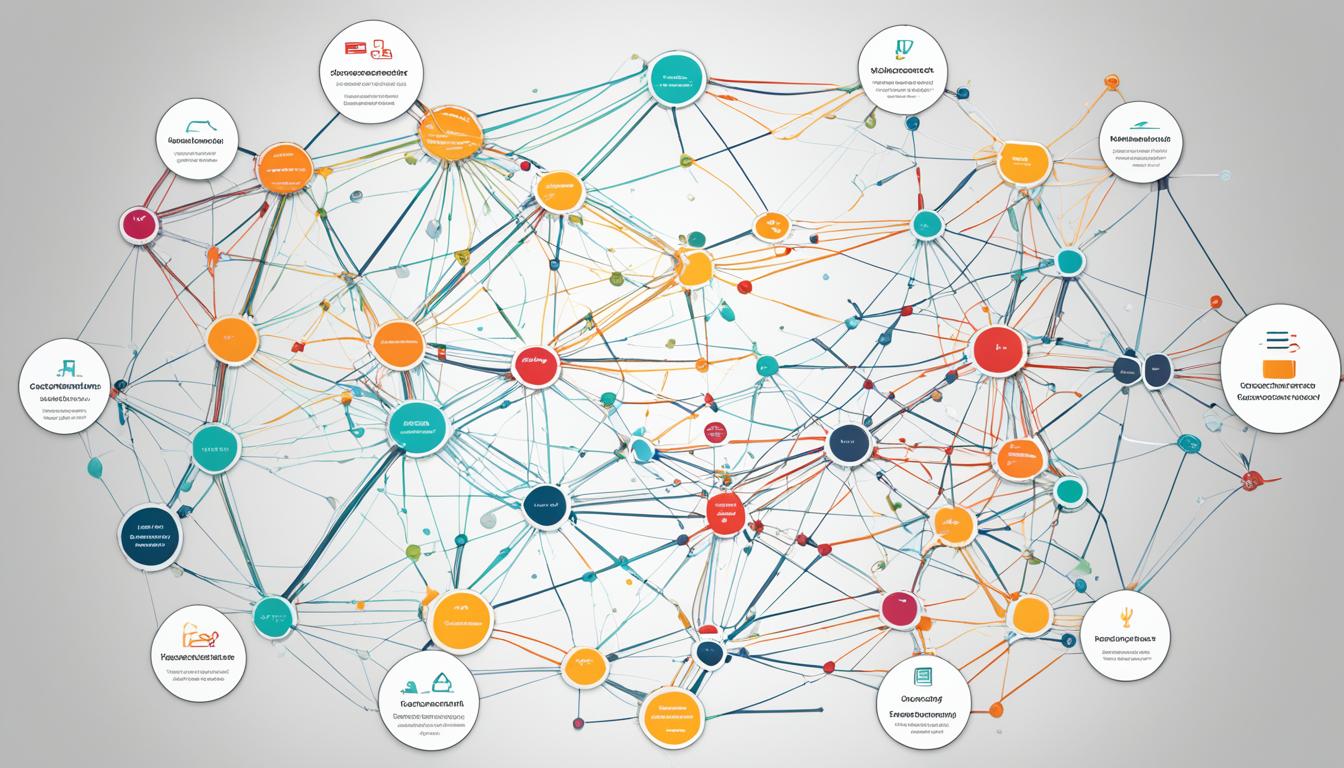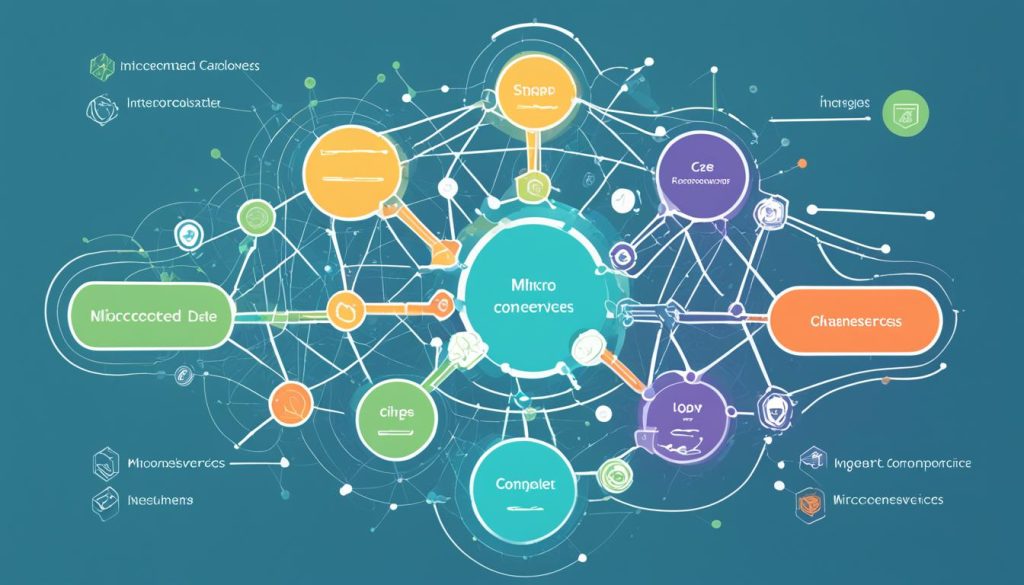
Microservices Architecture in Modern Applications
In the fast-paced realm of software development, microservices architecture stands out as a pivotal shift in building modern applications. This approach is transforming how organizations design, deploy, and manage their cloud-native applications. It offers a scalable and flexible solution to the digital age’s challenges.
Microservices architecture breaks down large, monolithic applications into smaller, independent services. These services communicate through well-defined APIs. This modular structure enables development teams to swiftly develop, maintain, and update services. It facilitates rapid application development, the addition of new features, and the launch of new services. The synergy between microservices and scalability is clear as organizations aim to deliver more dynamic and agile software solutions.
The rise of microservices has been closely tied to the growth of Kubernetes, an open-source container orchestration platform. Kubernetes aids in efficiently managing containers, building microservices architectures, and automating the software deployment pipeline. It’s essential in the microservices ecosystem.
Migrating to a microservices architecture marks a significant shift in software development. It emphasizes agility, fault tolerance, and scalability. Organizations transitioning to this approach must acknowledge the increased complexity in development and deployment. They also need to adapt their mindset and skillset within their teams. Yet, the advantages of microservices, such as independent scalability, improved fault tolerance, and adaptability to changing business needs, make it a strategic choice for modern applications.
Understanding Microservices Architecture
In the modern world of application development, the microservices architecture has become a leading approach. It breaks down a large application into smaller, independent services. Each service handles a specific business capability or function. This approach allows for better scalability, maintainability, and flexibility.
What is a Microservices Architecture?
This architecture is all about breaking down a system into smaller, independent services. These services talk to each other through APIs. This is different from the old way, where everything was one big, tightly connected unit.
Monolithic vs. Microservices: Key Differences
Monolithic and microservices architectures differ in structure and how they handle growth and changes. Monolithic apps are one big codebase, while microservices are many smaller services. Microservices are easier to scale and adapt to new needs.
- Monolithic apps are one big unit, while microservices are separate services.
- Scaling monolithic apps means scaling the whole thing, but microservices can be scaled one by one.
- Changes in monolithic apps affect everything, but in microservices, changes are limited to one service.
- Microservices use container technologies, like Docker, for easy deployment across different environments.
Microservices fit well with distributed systems, spreading resources across multiple nodes for better reliability and performance.
Benefits and Challenges of Microservices
Microservices, as a modern architectural style, bring numerous benefits that have made them increasingly popular. Yet, they also come with challenges that organizations must weigh before embracing them.
Advantages of Microservices
Scalability and Agility: Microservices enable the scaling of individual components independently. This allows businesses to swiftly adjust to evolving demands and user needs. Such flexibility boosts system scalability and agility.
Fault Tolerance: With microservices, a service failure does not affect the entire application. This isolation of faults ensures higher availability and uptime, making the system more resilient.
Flexible Technology Stack: Microservices permit the selection of different languages, frameworks, and technologies for each service. This choice leads to quicker development times and superior code quality.
Faster Deployment: Smaller, independent microservices can be deployed and updated swiftly. This enables organizations to roll out new features and fixes to customers rapidly.
Potential Drawbacks and Challenges
Service Coordination: Managing communication between multiple microservices can be intricate. It may increase development time and costs.
Data Management: Ensuring consistent data management across distributed microservices is challenging. It requires effective data synchronization and integration strategies.
Monitoring and Debugging: Identifying and resolving issues in a microservices-based system is more complex. The system’s complexity can lead to increased downtime and decreased productivity.
Security Concerns: The increased attack surfaces in a microservices architecture make securing the system a greater challenge. It necessitates dedicated security measures and strategies.
It is essential for organizations to understand both the benefits and drawbacks of microservices before adopting this architectural style in their software development.
Microservices Architecture in Modern Application
The software development landscape is evolving rapidly, with microservices principles becoming increasingly prevalent in modern application architecture. These principles facilitate the dynamic discovery, communication, and management of microservices. This ensures scalability, reliability, and flexibility in application development.
Core Principles of Microservices
The essence of microservices architecture lies in breaking down monolithic structures into smaller, independent units. These units communicate effectively with each other. This modular design fosters independent development, deployment, and scaling of components. It enhances agility and responsiveness.
Architectural Components
Essential components of a microservices ecosystem include:
- Service Discovery: These mechanisms enable services to find and communicate with each other dynamically. They ensure seamless integration and scalability.
- API Gateways: These act as centralized entry points. They manage and control access to microservices, simplifying interactions with clients.
- Containerization: Technologies like Docker package and distribute microservices as self-contained units. This enhances deployment and scalability.
- Orchestration: Platforms such as Kubernetes automate the deployment, scaling, and management of containerized microservices. They improve system reliability and availability.
These components work together to facilitate the dynamic discovery, communication, and management of microservices. They ensure scalability, reliability, and flexibility in modern application development.

Conclusion
Microservices architecture has revolutionized software development, tackling the constraints of traditional monolithic systems. It breaks down applications into smaller, independent services. This approach enhances scalability, agility, and the capacity to adapt swiftly to evolving demands. Although microservices come with challenges, their advantages make them a strategic option for building modern, cloud-based applications.
This architecture enables components to scale independently, managing increased traffic without disrupting other parts. Each microservice can be developed with the best technology, encouraging innovation and technology adoption. Failures in microservices are isolated, ensuring enhanced resilience and fault tolerance over monolithic systems. Moreover, microservices facilitate quicker development and deployment cycles, enabling agility in meeting business needs. Efficient resource allocation leads to cost savings and improved application performance.
Despite the complexities of implementing microservices, such as increased complexity, management overhead, and coordination among multiple components, their benefits are compelling. By adopting microservices, organizations can achieve greater scalability, flexibility, and agility. This positions them for success in the dynamic digital environment.